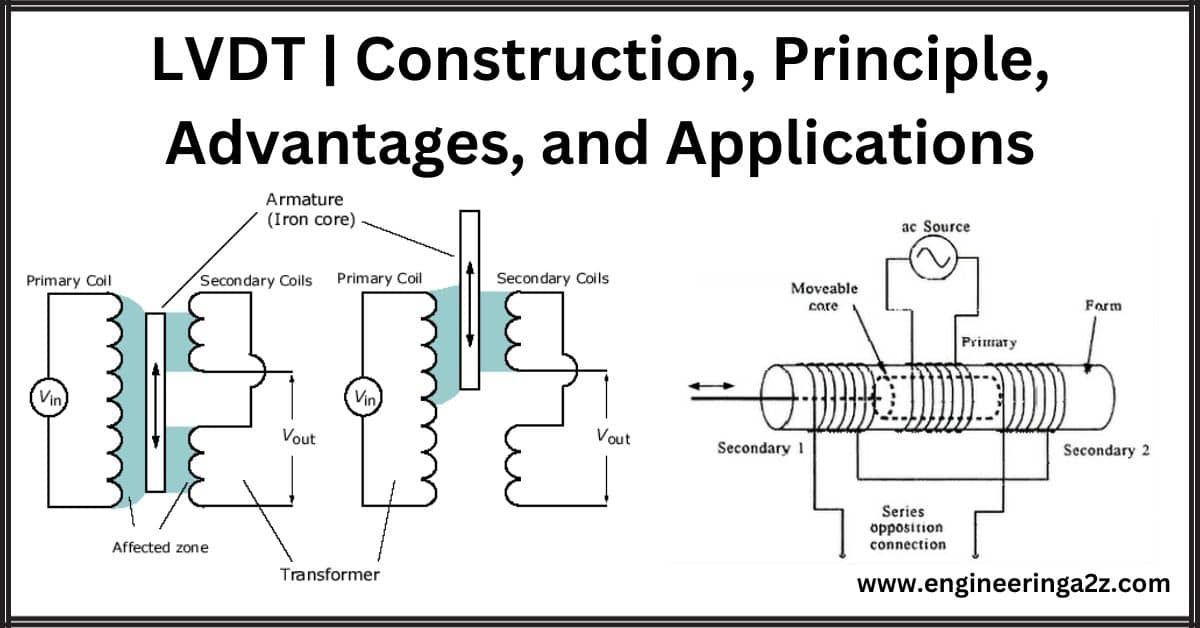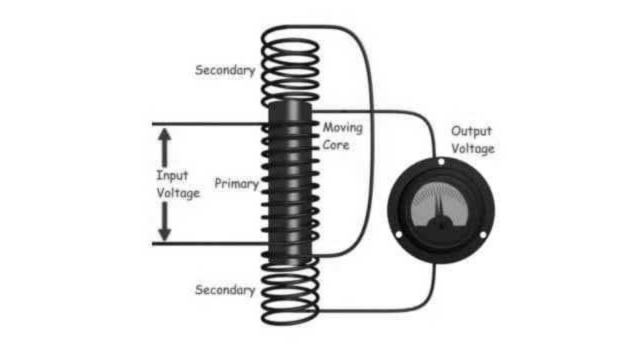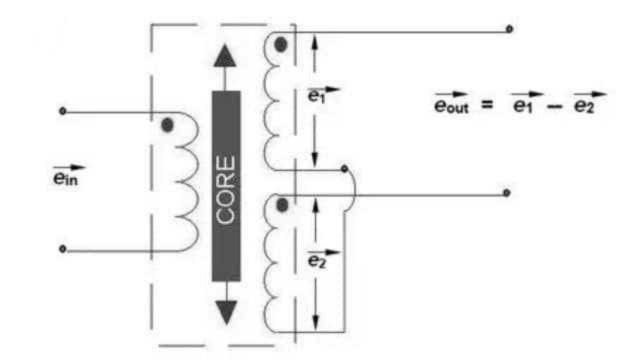
Table of Contents
Introduction
The term LVDT stands for Linear Variable Differential Transformer. It is the most widely used inductive transformer that converts linear motion into an electrical signal. The LVDT gets its name from the fact that it provides a special kind of output, called a “differential” output. It is a very accurate inductive transducer as compared to other transducers as there is no frictional err
Construction of LVDT

- The LVDT is a device that includes a primary winding (P) and two secondary windings (S1 and S2) wound on a hollow cylindrical former with a core.
- The primary winding is connected to an AC power source, creating a magnetic field in the air gap. This magnetic field induces voltages in the secondary windings.
- The secondary windings have the same number of turns and are positioned on either side of the primary winding.
- A movable soft iron core is placed inside the former, and it is connected to the object whose displacement is to be measured.
- The iron core is typically made of high permeability material to reduce harmonics and enhance the its sensitivity.
- This enclosed in a stainless steel housing to protect it from electrostatic and electromagnetic interference.
- The output of the LVDT is the difference between the voltages induced in the two secondary windings.
In summary, an LVDT is a displacement measurement device that uses the interaction of magnetic fields with a movable iron core to produce an output voltage based on the core’s position. It is typically housed in stainless steel for protection and provides a differential output from its two secondary windings.
Principle of Operation and Working
A Linear Variable Differential Transformer is a device that measures linear displacement or position by detecting changes in voltage in its secondary windings. The key principle of operation is based on the fact that the induced voltage in the secondary windings is proportional to the position of the core within the transformer. Here’s a simplified explanation:

- Core at Null Position (No Displacement): When the core is in its null position (no movement), the magnetic flux linking with both secondary windings (S1 and S2) is equal. This results in an equal induced voltage in both windings, so the output voltage (eout) is zero. In other words, when the core is at its reference position, there is no output voltage, indicating no displacement.
- Core Moved Upward (Positive Displacement): If the core is moved upward from its null position, the magnetic flux linking with S1 becomes greater than that linking with S2. As a result, the induced voltage in winding S1 (e1) becomes larger than in winding S2 (e2). This leads to a positive output voltage (eout), indicating a displacement in the upward direction.
- Core Moved Downward (Negative Displacement): When the core is moved downward from the null position, the magnetic flux linking with S2 becomes greater than that linking with S1. This causes the induced voltage in winding S2 (e2) to be larger than in winding S1 (e1), resulting in a negative output voltage (eout). This negative output voltage indicates a displacement in the downward direction.
- Linear Relationship: The relationship between the output voltage (eout) and the core’s displacement is linear. This means that as you move the core further from its null position, the output voltage increases or decreases proportionally, allowing you to accurately measure the magnitude and direction of the core’s movement.
In summary, an LVDT is a sensor that produces an output voltage proportional to the linear displacement of its core. The magnitude and direction of the displacement can be determined by observing the sign and amplitude of the output voltage, with a linear relationship between the two. This makes a useful tool for precise position measurements in various applications.
Advantages of LVDT
- Large Measurement Range: LVDTs can measure a wide range of displacements, from as small as 1.25 millimeters to as large as 250 millimeters. In simple terms, they’re versatile for measuring how things move over a broad distance.
- No Friction: LVDTs are very accurate because they don’t suffer from the losses caused by friction. This means that the input displacement is precisely converted into an electrical signal without any loss.
- Strong Output: LVDTs produce a strong output signal, which means you don’t need extra equipment to make the signal usable. They’re highly sensitive and can generate around 40 volts for every millimeter of movement.
- Low Hysteresis: LVDTs have low hysteresis, which means they provide consistent and reliable measurements, regardless of whether the movement is increasing or decreasing.
- Low Power Consumption: They are energy-efficient, consuming only about 1 watt of power, which is much less compared to other similar devices.
- Direct Electrical Signal Conversion: LVDTs directly convert linear movement into an electrical voltage, making it easy to work with and process the measurements. In simple terms, they make it straightforward to understand how something is moving by using electrical signals.
Disadvantages of LVDT
- Sensitive to Stray Magnetic Fields: LVDTs are sensitive to magnetic fields that are not part of their intended measurement. To ensure accurate readings, they need to be shielded or protected from these unwanted magnetic fields.
- Temperature Sensitivity: LVDTs can be influenced by changes in temperature. It’s important to account for temperature variations when using them for measurements to maintain accuracy.
Applications of LVDT
- Industrial Automation
- Aerospace
- Civil Engineering
- Medical Devices
- Nuclear Power Plants
- Material Testing
- Energy Protection
- Oil and Industry
Frequently Asked Questions (FAQs)
What is LVDT?
An LVDT, which stands for Linear Variable Differential Transducer /Transformer, is a type of electrical device used for measuring linear displacement or position. It is essentially a sensor that converts the physical motion of an object into an electrical signal.
What is an LVDT used for?
LVDTs are used for highly accurate linear position measurements. Common applications include industrial machinery control, aircraft and automotive systems, and scientific instruments due to their reliability and precision.
Is LVDT AC or DC?
LVDTs (Linear Variable Differential Transformers) operate on AC (alternating current) voltage. They require an AC power source to induce voltages in their coils and measure linear displacement accurately.
Which material is used in LVDT?
LVDTs typically use materials such as stainless steel for the housing and a high-permeability material like soft iron or nickel-iron alloy for the movable core. These materials are chosen for their durability and magnetic properties, which are essential for the LVDT’s operation.
Read Also:
- Block Diagram Reduction | Control System
- DC Generator | Construction and Working Principle
- Chopper | Types of Chopper | Applications of Chopper
- Basic Electrical Engineering | Engineeringa2z
- Block Diagram Reduction | Control System





Leave a Reply